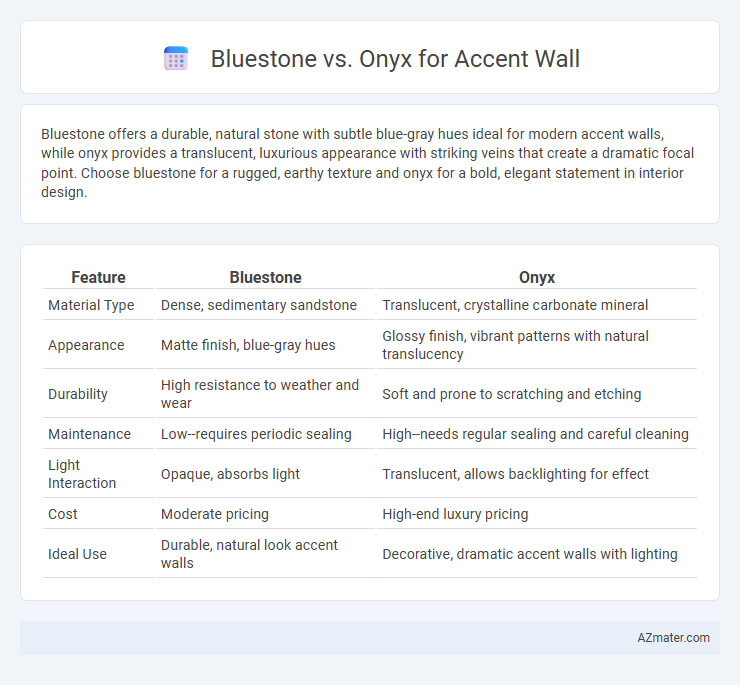Bluestone offers a durable, natural stone with subtle blue-gray hues ideal for modern accent walls, while onyx provides a translucent, luxurious appearance with striking veins that create a dramatic focal point. Choose bluestone for a rugged, earthy texture and onyx for a bold, elegant statement in interior design.
Table of Comparison
| Feature | Bluestone | Onyx |
|---|---|---|
| Material Type | Dense, sedimentary sandstone | Translucent, crystalline carbonate mineral |
| Appearance | Matte finish, blue-gray hues | Glossy finish, vibrant patterns with natural translucency |
| Durability | High resistance to weather and wear | Soft and prone to scratching and etching |
| Maintenance | Low--requires periodic sealing | High--needs regular sealing and careful cleaning |
| Light Interaction | Opaque, absorbs light | Translucent, allows backlighting for effect |
| Cost | Moderate pricing | High-end luxury pricing |
| Ideal Use | Durable, natural look accent walls | Decorative, dramatic accent walls with lighting |
Introduction to Bluestone and Onyx Accent Walls
Bluestone accent walls feature natural stone with a rugged texture and shades ranging from blue-gray to earthy tones, offering durability and a timeless aesthetic for interior or exterior spaces. Onyx accent walls showcase translucent layers and rich, vibrant colors, creating dramatic visual effects with natural backlighting that highlights their unique veining patterns. Both materials provide distinct design elements--bluestone emphasizes rustic elegance while onyx delivers a luxurious, luminous focal point.
Visual Appeal: Bluestone vs Onyx
Bluestone offers a natural, earthy visual appeal with its muted blue-gray tones and subtle texture, creating a calm and sophisticated accent wall. Onyx features a striking, translucent quality with vibrant pigmentation and intricate veining that adds a luxurious, dramatic focal point. Choosing between Bluestone and Onyx depends on the desired ambiance, where Bluestone suits understated elegance and Onyx delivers bold, high-impact aesthetics.
Durability and Longevity Comparison
Bluestone offers exceptional durability due to its dense and fine-grained composition, making it highly resistant to wear and weathering, ideal for long-lasting accent walls. Onyx, while prized for its luxurious appearance and translucent qualities, is softer and more prone to scratching and etching, which may reduce its longevity in high-traffic areas. For accent walls requiring sustained durability, Bluestone outperforms Onyx by maintaining structural integrity and aesthetic appeal over extended periods.
Maintenance Requirements
Bluestone accent walls require minimal maintenance, needing only occasional sealing to protect against moisture and staining, making them highly durable for both indoor and outdoor applications. Onyx accent walls demand more frequent upkeep due to their softer, more porous nature, requiring regular sealing and careful cleaning to prevent scratching and damage from acidic substances. Choosing Bluestone over Onyx reduces long-term maintenance efforts, enhancing longevity and preserving aesthetic appeal with less intensive care.
Cost Differences Explained
Bluestone and Onyx differ significantly in cost for accent walls due to their rarity and material properties. Bluestone, a natural sandstone, typically costs between $10 to $30 per square foot, making it more budget-friendly for larger projects. Onyx, valued for its translucent qualities and aesthetic appeal, can range from $40 to $100 per square foot, reflecting higher material and fabrication expenses.
Installation Process: Bluestone and Onyx
Bluestone installation for accent walls requires heavy-duty anchors and mortar due to its dense, natural stone composition, ensuring durability and a rustic aesthetic. Onyx panels, being translucent and softer, demand careful handling with specialized adhesives and backlighting considerations to preserve their luminous quality. Both materials necessitate precise cutting tools, but Onyx requires more delicate measures to prevent cracking during the installation process.
Versatility in Interior Design
Bluestone offers a natural, textured surface with cool grey and blue hues, making it ideal for creating a serene, rustic accent wall that complements modern and traditional interiors. Onyx provides a striking, translucent appearance with rich, warm colors and unique patterns, allowing for dramatic backlit accent walls that enhance luxury and sophistication in contemporary spaces. Both materials exhibit versatility, but Bluestone suits more subtle, earthy designs while Onyx caters to bold, opulent aesthetics.
Eco-Friendliness and Material Sourcing
Bluestone and Onyx offer distinct advantages for eco-friendly accent walls, with Bluestone typically sourced from natural quarries known for sustainable extraction practices and minimal environmental impact. Onyx, a semi-precious stone, often involves more energy-intensive mining and processing, raising concerns about carbon footprint and resource depletion. Choosing Bluestone supports greener construction due to its abundant availability and lower embodied energy compared to the rarer and more resource-heavy Onyx.
Best Applications for Each Stone
Bluestone excels in outdoor accent walls due to its durability, weather resistance, and natural blue-gray hues that complement garden and patio designs. Onyx, prized for its translucency and rich, vibrant colors, is ideal for indoor accent walls where backlighting can enhance its dramatic, luxurious appearance. Both stones suit distinct aesthetic goals, with Bluestone favoring rugged, natural environments and Onyx enhancing elegant, high-impact interior spaces.
Choosing the Right Stone for Your Accent Wall
Bluestone offers a natural, textured surface with earthy tones, making it ideal for creating a rustic or organic accent wall that complements outdoor or nature-inspired interiors. Onyx provides a striking, translucent appearance with rich, vibrant colors, perfect for dramatic accent walls that benefit from backlighting or a polished, luxurious finish. Selecting the right stone depends on your design goals, lighting conditions, and maintenance preferences, with Bluestone suitable for durability and subtlety, and Onyx for visual impact and elegance.

Infographic: Bluestone vs Onyx for Accent Wall
 azmater.com
azmater.com